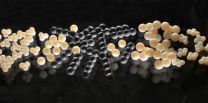(Press-News.org) Prof. Heinrich Jaeger's research group examines materials and phenomena that appear simple at the surface, but which reveal tremendous complexity upon close examination. One such phenomenon is jamming, in which aggregates of randomly placed particles, including spheres or more complicated shapes, or even molecules, transition from fluid-like to solid-like behavior.
Jamming lends itself to soft robotics, in addition to other applications as explored in a workshop at the University of Chicago last October. In recent computer simulations and experiments, Jaeger, the William J. Friedman & Alicia Townsend Professor in Physics, and graduate student Marc Miskin investigate another aspect of jamming. They analyzed how the properties of a jammed material can be tuned by changing the shape of the constituent particles. Their results on "Adapting granular materials through artificial evolution" appeared Jan. 20 as an Advance Online Publication in Nature Materials.
Miskin and Jaeger addressed a daunting question in their research: Given a design goal for the jammed aggregate, for example to have it as stiff or as soft as possible in response to an applied force, what particle shape will best produce the desired outcome? For this complex optimization problem, they faced an infinite variety of shapes to choose from. So Miskin employed a computer algorithm—referred to as an "evolutionary optimization" in the accompanying video—to answer this question.
The computer designed particles by starting from a random shape, and then iteratively altered its configuration, at each stage performing a series of simulations that tested how close the performance approximated the stated goal. Once an optimal shape was identified, Miskin then manufactured a large number of copies with the lab's 3D printer for testing in a viselike squeezing apparatus to verify his algorithm's predictions.
INFORMATION:
Physicists use 3-D printing to test complex qualities of shapes made via computer
2013-03-19
ELSE PRESS RELEASES FROM THIS DATE:
New nanomedicine resolves inflammation, promotes tissue healing
2013-03-19
NEW YORK, NY (March 18, 2013) —A multicenter team of researchers, including scientists at Columbia University Medical Center (CUMC), Brigham and Women's Hospital (BWH), Mount Sinai School of Medicine, and Massachusetts Institute of Technology, has developed biodegradable nanoparticles that are capable of delivering inflammation-resolving drugs to sites of tissue injury. The nanoparticles, which were successfully tested in mice, have potential for the treatment of a wide array of diseases characterized by excessive inflammation, such as atherosclerosis. The study was published ...
Sleep study reveals how the adolescent brain makes the transition to mature thinking
2013-03-19
(SACRAMENTO, Calif.) -- new study conducted by monitoring the brain waves of sleeping adolescents has found that remarkable changes occur in the brain as it prunes away neuronal connections and makes the major transition from childhood to adulthood.
"We've provided the first long-term, longitudinal description of developmental changes that take place in the brains of youngsters as they sleep," said Irwin Feinberg, professor emeritus of psychiatry and behavioral sciences and director of the UC Davis Sleep Laboratory. "Our outcome confirms that the brain goes through a ...
Toyota's management practices may improve the quality of hospital care
2013-03-19
PORTLAND, Ore. — Researchers have long surmised that management techniques successful in manufacturing and technology sectors may improve health care quality. However, there has been very little evidence about how these practices are disseminated in hospitals and whether they are associated with better performance.
A new study led by Oregon Health & Science University (OHSU) health economist K. John McConnell, Ph.D., reveals manufacturing management practices, including Toyota's "Lean" methodologies, may be beneficial in helping hospitals achieve "high-quality health ...
Gene profile may help identify risk for hormone-sensitive, hormone-insensitive breast cancer
2013-03-19
PHILADELPHIA — The overexpression or underexpression of a newly identified set of genes related to lipid metabolism may help physicians identify whether or not a woman is at risk for hormone receptor-positive or hormone receptor-negative breast cancer and to subsequently tailor prevention strategies appropriately, according to data published in Cancer Prevention Research, a journal of the American Association for Cancer Research.
"Currently, three drugs can be used to prevent breast cancer in women who are at extremely high risk for the disease," said Seema A. Khan, ...
Combined hyperbaric O2 -- normobaric hyperoxia associated with improved outcome of severe TBI
2013-03-19
Charlottesville, VA (March 19, 2013). Researchers at the Hennepin County Medical Center, University of Minnesota, and Minneapolis Medical Research Foundation (Minneapolis, Minnesota) report that the combined use of hyperbaric oxygen and normobaric hyperoxia therapies provides better outcomes in patients with severe traumatic brain injury (TBI) than the standard intensive neurosurgical care recommended for this injury. Full details on the effects of this combined treatment are provided in the paper "A prospective, randomized Phase II clinical trial to evaluate the effect ...
Genes identify breast cancer risk and may aid prevention
2013-03-19
CHICAGO --- A newly identified set of genes may predict which women are at high risk for getting breast cancer that is sensitive to estrogen and, therefore, would be helped by taking drugs to prevent it, reports a new Northwestern Medicine study.
"We now have the possibility of predicting if a preventive drug will work for a woman at high risk of breast cancer, so that we don't expose women to the risks and side effects of this drug if it won't help them," said Seema Khan, M.D., senior author of the study, which will be published March 19, 2013 in the journal Cancer ...
Military personnel return to duty following severe injury to lower extremity
2013-03-19
CHICAGO – High-energy lower-extremity trauma (HELET) is common in modern warfare, often resulting in severe tissue damage, chronic pain, neurovascular injury and significant muscle loss, according to the new research presented today at the 2013 Annual Meeting of the American Academy of Orthopaedic Surgeons (AAOS).
The Return to Run (RTR) program is an integrated orthotic and rehabilitation initiative designed to return high-level function to wounded warriors. It includes use of the new Intrepid Dynamic Exoskeletal Orthosis (IDEO), a custom-fit device made from carbon ...
Depression in Alzheimer's patients associated with declining ability to handle daily activities
2013-03-19
New York, NY (March 18, 2013)—More symptoms of depression and lower cognitive status are independently associated with a more rapid decline in the ability to handle tasks of everyday living, according to a study by Columbia University Medical Center researchers in this month's Journal of Alzheimer's Disease.
Although these findings are observational, they could suggest that providing mental health treatment for people with Alzheimer's disease might slow the loss of independence, said senior author Yaakov Stern, PhD, professor of neuropsychology (in neurology, psychiatry, ...
Origins of human teamwork found in chimpanzees
2013-03-19
Teamwork has been fundamental in humanity's greatest achievements but scientists have found that working together has its evolutionary roots in our nearest primate relatives – chimpanzees.
A series of trials by scientists found that chimpanzees not only coordinate actions with each other but also understand the need to help a partner perform their role to achieve a common goal.
Pairs of chimpanzees were given tools to get grapes out of a box. They had to work together with a tool each to get the food out. Scientists found that the chimpanzees would solve the problem ...
Laser-like photons signal major step towards quantum 'Internet'
2013-03-19
The realisation of quantum networks is one of the major challenges of modern physics. Now, new research shows how high-quality photons can be generated from 'solid-state' chips, bringing us closer to the quantum 'internet'.
The number of transistors on a microprocessor continues to double every two years, amazingly holding firm to a prediction by Intel co-founder Gordon Moore almost 50 years ago.
If this is to continue, conceptual and technical advances harnessing the power of quantum mechanics in microchips will need to be investigated within the next decade. Developing ...

